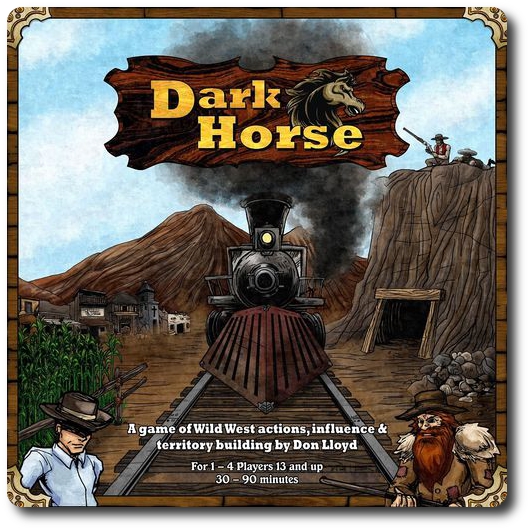
The Basics:
- For ages 7 and up (publisher suggests 13+)
- For 1 to 4 players
- About 60 minutes to complete
Geek Skills:
- Active Listening & Communication
- Counting & Math
- Logical & Critical Decision Making
- Reading
- Strategy & Tactics
- Risk vs. Reward
- Hand/Resource Management
- Trading
- Worker Placement & Area Control
Learning Curve:
- Child – Moderate
- Adult – Easy
Theme & Narrative:
- Welcome to the Frontier! A wild and open land that is full of endless possibilities and great fortune…if you are smart enough to know how to get it.
Endorsements:
- Gamer Geek approved!
- Parent Geek approved!
- Child Geek approved!
Overview
In Dark Horse, by Knight Works, the players take on the roles of opportunists that are looking to carve their own little piece of paradise out of the Old West. There is great fortune to be had but only a few know how to get it. Even fewer know how to keep it. Opportunity and treachery are around every corner and knowing when and where to focus attention is going to be the real test. Wield your influence wisely, reveal little, and watch your opponents carefully.
Dark Horse is comprised of 12 City tokens, 24 Town tokens, 55 Rail tokens, 13 six-sided dice, 1 silver Deputy die, 73 Resource Tokens (Food, Wood, and Ore), 12 Gold Tokens, 8 Player discs, 4 Player pawns, 20 Resource Hex Tiles (Food, Wood, and Ore), 34 various tokens (Wild Die, Engineer, Stocks, Loans, and Traders), 27 Action cards, 7 Character cards, 1 Reference card, 2 game markers, and 1 Sheriff & Mayor token. The game bits (of which there are many), are of high quality and either made of thick cardstock or are wood. The theme of the Old West is used throughout well and helps keep the feeling of the game on track.
Note: Dark Horse is a rather large game. Large, but not overly complicated. It would take longer than either you or I have patience for to describe each and every facet of this game, so I will summarize, highlighting what I think is the most important and interesting parts of the game. I encourage you to read the game’s rule book for more details of what this game has to offer.
The Game Board
The game board is the real story to this game. On its surface, the players will be expanding their territory by placing cities and towns, keep track of and adjust their turn order, assign and control actions, buy and sell goods, adjust their level of influence, and there is even a space to represent a jail cell waiting to hold unlucky players. Everything on the game board is clearly labeled and is easy to use. There is a great deal of information and tracking done on the board which means the players will be almost entirely focused on it from start to finish.
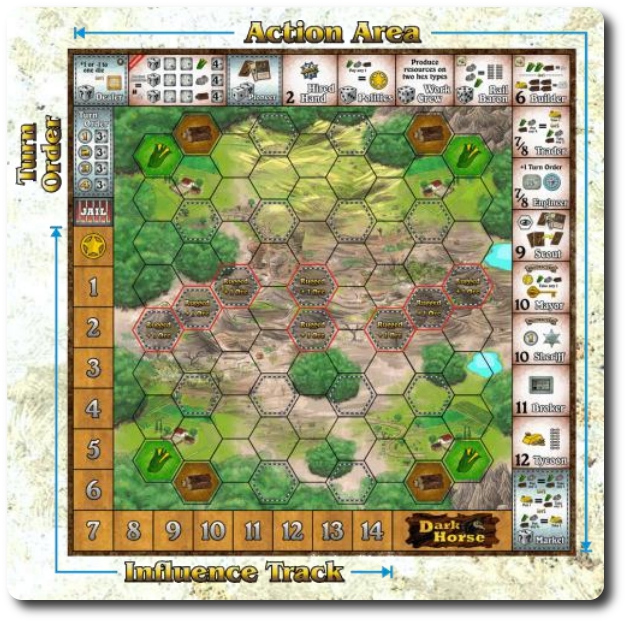
The game board and all the information it contains and tracks
The Role of Dice
Players use dice to obtain control over spaces in the action area of the board. This is done by rolling and then placing one, two, or more dice in specific spots or multiple spots in the action area. Some spots can only be used by one player while others can be used by all players at once. Some spaces even included restrictions and special rules that dictate when they can be used.

Example of just some of the actions the players can attempt to take during their turn
The action spaces allow the players to do whatever action is noted on them and nothing else. This is rather limiting, but is also the only way a player can do anything in the game. This is further complicated by some of the actions requiring a specific value on the dice to be used while others require a value range or anything at all. There is also nothing in the game to stop a player from grabbing an action space making it unavailable to the other players for the single purpose of blocking access.
Resources, Towns, Cities, and Railroads
There are only three resources in the game that are used to hire workers, obtain influence, and even barter and trade. These are food, wood, and ore. These are the essential building blocks for just about everything that will need to be done and paid for. There is also gold to be obtained and is needed to complete a few of the action spaces. While technically not one of the three resources, gold can be used to purchase resources if the player is short.
Players receive resources by choosing it as an action, but that player must own and control the lands around his city and towns to harvest them. This will limit some players greatly as they will not have the necessary resources to complete actions. Lucky for everyone, there is Market action space that allows players to trade in their resources to purchase others. This allows all players to continue to participate in building even if they do not yet have access to the raw resources necessary by default.
Towns and cities in the game are means to an end when it comes to resource collection and area control. Cities are used as a pivot point from which towns are built and also reveal hidden resources on the game board. Towns must be built around cities and can only be placed on spaces on the game board that provide a resource. By building railroads, the player can place towns away from their cities as long as it is connected via the railways. In this way, a player can expand their control and collect additional resources by pushing into new territory.
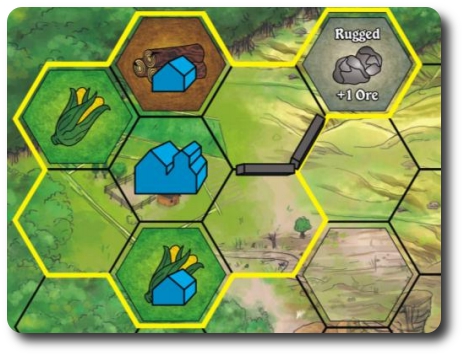
Example of a city, towns, and the railroad
While exploring the new territory, players will encounter land that is rougher and tougher, making the resources more difficult to get to at first. These are referred to as “rugged resources” and will cost the player more to build on than normal resource spaces.
Character Cards
The game can be daunting for new players and a little bit of direction can help a player down a path to victory. The Character cards provide the players with unique abilities and special advantages. None of which, I must add, are “game breaking” or overpowered, but they do give the player some direction. For example, the Scoundrel Character card gives the player the ability to use Wild Dice and use the Action cards in a unique way not available to the other players. This can help direct the player’s play. Of course, it can also be limiting, but a player is never forced to use any of the Character card abilities.
On each of the Character cards, the player will find a “Start Game” box that awards the player an initial number of resources. All players start with resources, but depending on the Character card, the player’s starting resources might be very different from the other players. Character cards also have an “Ability” box that lists the special bonuses and abilities available to the player.
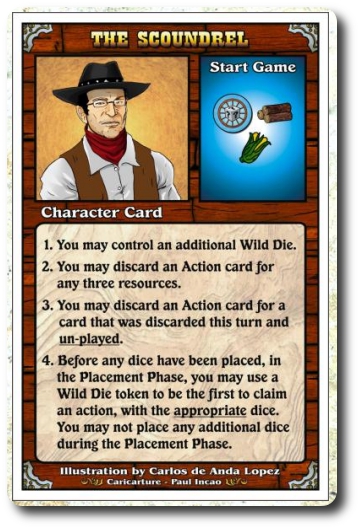
One of the seven Character cards available to the players
On a related note, individuals familiar with the various personalities in the board game universe, both designers and highly respected reviewers, will recognize that the Character cards are based off of real people. For example, the Scoundrel Character card depicts an illustration of game designer, Paul Incao. Not that Mr. Incao is a “scoundrel”, mind you.
Action Cards
The Action cards are something of a mixed bag when it comes to the game and the benefits to the players. They can be exceedingly powerful but they have to important limitations that make them somewhat of a double-edged sword. First, timing is crucial when playing an Action card. This is where the hand management Geek Skill comes into play. If the player does it right, they’ll have a one time advantage over the other players that might jump them ahead. Played wrong, and the Action card is wasted. Some Action cards also penalize the player when used, where the player must pay whatever the Action card asks for. This can be costly, especially when it is towards the end of the game and the Action card demands a sacrifice of influence points.
The Action cards are broken down into two specific groups. The first is the Action card that gives the character who uses them a one time bonus for that game round. Once played, Action cards are discarded. The second is the Event card that impacts all the players in the game as soon as it is drawn and remains in play for the duration of the game or until it is removed by another card.
Playing and Winning the Game
Dark Horse is played in rounds and has two distinct phases. These are the Placement phase (where the players roll their dice and then place them on the board) and the Collection Phase (where the players collect their dice and use the action noted on the Action space on the game board). The turn order of the game shifts as the players have the ability to adjust their position using their dice during the Placement phase.
The game continues, with a single Placement and Collection phase every round, until one of the two following conditions are met:
- A player places their last city and town tokens on the game board
- A player reaches or moves past the “Game End” on the Influence Track on the game board
As soon as any player completes one of the following above conditions, the game ends but not before each player is allowed to finish their actions in the Collection phase. Once all the players are done, points are counted. Victory points are counted and based off of a player’s gold, influence points, number of cities and towns connected by railroads, and controlling special roles in the game (available form Action spaces). Players can lose points if they have unpaid loans or having a die they own in the Jail space of the game board.
Once all the points are totaled, the player with the most points wins!
Game Variants
There are two game play variants that are available out of the box to the player. They are as follows:
- Two-Player Game: adds a “gunslinger” to the game that can be moved by one player to block another player’s ability to use an Action space in the game
- Solitaire Game: played very much like the normal game except it provides three levels of difficulty and the victory condition is based on different scenarios
To learn more about Dark Horse, see the game’s official web page.
Prediction
My little geeks are going to need time to absorb this game. Not because it is terribly difficult, but because of the use of dice. You see, Dark Horse does use luck to randomize what a player can and cannot do during their turn. This can be a problem for little geeks who are still learning the basics of turn order and multi-step game phases. My little geeks have already been exposed to games where the roll of the dice can determine what a player can and cannot do, but the scale of Dark Horse makes the many choices that become limited in selection depending on the dice values rolled, anything but simple.
My 4-year-old is out for this one. Dark Horse demands just one to many Geek Skills he has not yet mastered enough to play the game well. As a partner, however, he’ll be fantastic. He won’t be going at this game in a chair of his own, but he has always been a wonderful team player. This also gives me a chance to teach him the game and keep him involved.
My 7-year-old should be able to manage this game, but not at first. I think the best approach is to focus on the different actions the players can take during their turn and what it all means. Taken individually, the game is not that complex or difficult to understand. The complexity is knowing where to place the dice based on the rolled values and knowing how to prioritize and understand the value of the action as it pertains to obtaining the player’s goals.
Not an easy task.
And so, we’ll take it one step at a time, answer questions, dig deeper into the game as each level is explored, and eventually be able to play the game in its entirety. This is how I pitched the game to my little geeks and they were both eager to begin. This was especially true when I said we’d be taking this game slow. You could see the stress melt from my 7-year-old’s face as he breathed a sigh of relief. It was then that I asked my little geeks their thoughts on the game.
“The game looks tough, but I know we can play it if we take our time.” ~ Liam (age 7)
“As long as I am on your team, Daddy, I’ll be OK.” ~ Nyhus (age 4)
My little geeks are ready to go! Let’s start the education and see if the lessons stick or if this is a game well out of their territory.
Final Word
A word of caution for those Parent Geeks who want to teach this game to their little geeks. The minimum age for this game is accurate in respect to the amount of time, energy, and skill the game requires from all its players. However, this is just a recommendation and the game can be difficult for younger and older players, alike. All one needs to do is learn the game, and on that point, I have two suggestions. First, be prepared to teach the new and inexperienced players the game over several sessions, especially the little geeks. There is a lot to absorb in the game, but it can be broken down and taught if you and your little geek take the time and have the patience for it. I have been asked how I get my little geeks to play complicated games that are not in their age group. Simply put, I make the time and dedicate myself to teaching the games to them because I know the payoff is going to be huge. Second, there is a bit of backstabbing in this game. As already stated, a player has the option of placing their dice in location during the Placement phase of the game to block other players. I highly suggest you create and enforce a House Rule when playing with little geeks that states you cannot place your dice on a spot if you (1) do not intend to use it or (2) pay for it. The game can be difficult enough, and taking a spot the little geek could use is a slap in their face that they might not be able to emotionally handle. Of course, you know your kids better than anyone else, so use your best judgement.
My little geek enjoyed the game after he understood the basics and then was able to develop a strategy that worked for him. Oddly enough, the Character cards seemed to hurt him when I thought for certain it would help him down a possible path to achieve victory. In his own words, he “had his own ideas” and wanted to try them out. I certainly cannot fault him there and was overjoyed when I saw him trying to bend the boundaries of the game and explore what would or would not work. This attitude of exploration and risk taking will serve him well.
The Parent Geeks I played with were already familiar with The Settlers of Catan, Carcassonne, Ticket to Ride, and Kingsburg. Knowing these games allowed them to quickly understand the different game mechanisms and how to play it. One Parent Geek was even familiar with Alien Frontiers, which only served to help her play even stronger. That being said, Dark Horse shares certain game mechanisms from these games but is a completely separate and standalone game in of itself. I don’t want you going off thinking this game is just a retread, because it certainly isn’t. Nor is it a hodgepodge of rules thrown together. The game is solid and stands on its own without issue.
Gamer Geeks, of course, recognized the game mechanism almost at once. From a Gamer elitist point-of-view, there is nothing new going on here. What is new is how the game mechanisms and bits are being used together. For some Gamer Geeks, this was something of a turnoff as the game felt to them to be nothing more than a buffet of other games thrown together in one box. Other Gamer Geeks were overjoyed to see the game use tried and true game mechanisms in a new way and pulling them together to make a cohesive and challenging game.
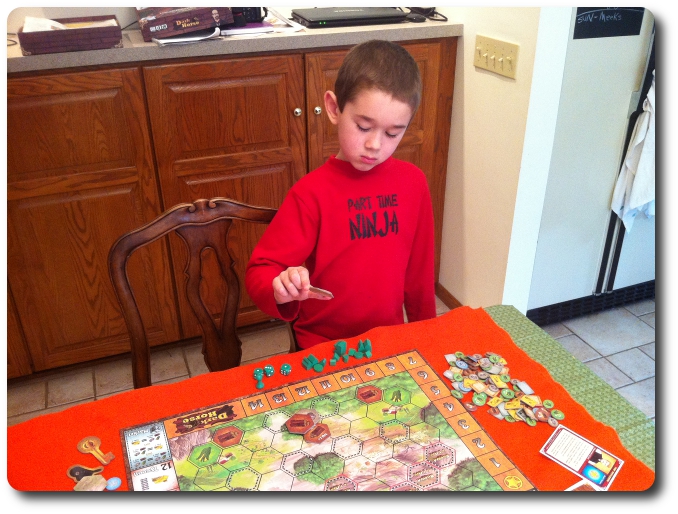
While I get the table snacks ready, my little geek sets up the game
Gamer Geeks, this game is geek approved! It mixes a small number of familiar game mechanisms together in a unique way to make the game feel new and at the same time, familiar. The theme is handled well throughout and the Character cards add a slight twist to the game by making the road to victory slightly different for each player. The game plays fast, is intuitive, and always gives the players something to do. Luck does play a role in the game, but only when we consider that the roll of the die determines what the player can and cannot do for the round. It is still up to the player to determine how best to use their dice and for what purpose. The end result is an entertaining and challenging game you will enjoy.
Parent Geeks, this is one of those games you can play with your family and friends, but with some difficulty. The game is not complicated, but there is a lot to think about. Dark Horse can be can be taught in 10 minutes or less, but not a game that is necessarily understood. The complexity is in the details of the game and being able to logically decide which of the actions available to you is the best course of action to take. Depending on the dice rolls, the choices can be very simple or complex. That being said, Dark Horse provides for a lot of great Geek Skill improvement! For non-gamers or for those who are not interested in more meatier games, Dark Horse should be skipped.
Child Geeks, this won’t take long to learn but you’ll be struggling at first to understand how everything works. The game board can be intimidating, but as soon as you realize that you only have to work with a small part of it during any round of the game, you’ll be set. Keep in mind at all times how the game ends and then do everything you can to assign your dice to obtain points. Do expect to be frustrated when other players take spots you want, but you’ll never be left without options. Build your cities, towns, and expand!
Dark Horse scratched an itch I didn’t know I had. I am already familiar with and somewhat bored by worker placement games that involve dice. Not because they are bad games, but because I have played so many of them. In fact, it was all me Gamer Geek elitist group played for some time. I guess you could say I was burnt-out. Dark Horse rekindle my spark and I loved how it incorporated so many aspects of other game that didn’t feel like old news. While Dark Horse is not breaking any ground in new ways to play, it is a very entertaining game. It has that “just right” feel to it that leaves me satisfied with my experience, win or lose, when the game is over.
Do give Dark Horse a look and sit down at the table to give it a play if the opportunity should present itself. You will not regret it.
This game was given to Father Geek as a review copy. Father Geek was not paid, bribed, wined, dined, or threatened in vain hopes of influencing this review. Such is the statuesque and legendary integrity of Father Geek.




Pingback: Father Geek » Garden Dice Game Review
Pingback: Dark Horse: Rebels & Rogues Game Expansion Review (prepublished version) » Father Geek